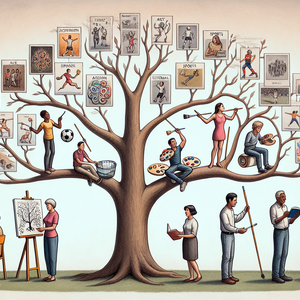The Cost of Living Crisis: Average Salaries vs. Inflation

The past few years have witnessed a dramatic increase in inflation rates, reaching levels not seen in decades. Several factors have contributed to this surge, including supply chain disruptions due to the COVID-19 pandemic, pent-up consumer demand, and geopolitical tensions impacting energy prices. According to the Bureau of Labor Statistics, the Consumer Price Index (CPI)—a principal measure of inflation—rose by approximately 7% in 2021 and continued its upward trajectory into 2022. This rapid escalation in prices has raised significant concerns about the cost of living for average Americans, highlighting the urgent need to understand this economic phenomenon.
Average Salary Growth vs. Inflation
While many workers have experienced nominal wage increases, these raises often fall short of keeping pace with inflation. Data from the U.S. Department of Labor shows that average hourly earnings for private-sector employees rose by about 4% in 2021. However, when adjusted for inflation, real wage growth has been negative, meaning that employees are effectively earning less than they did before. For instance, a worker earning $50,000 in 2020 would need to earn approximately $53,500 in 2022 to maintain the same purchasing power if inflation were considered. This discrepancy underscores a critical issue: while salaries may seem to rise, the real value of those wages diminishes when inflation is factored in.
Impact on Purchasing Power
The erosion of purchasing power is a direct consequence of the disparity between salary growth and inflation. As prices rise, consumers find themselves able to buy less with their existing income, leading to challenging decisions regarding spending and saving. A report from the Economic Policy Institute reveals that the average American worker has seen their real wages stagnate or decline over the past two decades. This stagnation exacerbates financial strain and contributes to a widening wealth gap, highlighting the need for a deeper understanding of the economic forces at play.
Regional Disparities in Salary and Cost of Living
The effects of inflation and salary growth are not uniform across the United States; rather, they vary significantly by region. Some areas experience higher costs of living driven by factors like housing demand and local economic conditions. For instance, cities such as San Francisco and New York have seen housing prices soar, often outpacing salary increases for many residents. In contrast, regions with lower living costs might offer more stable purchasing power, but often at the expense of lower average salaries. Take, for instance, the contrast between a tech worker in Silicon Valley, where average salaries can exceed $120,000, and a service worker in the Midwest earning $30,000. While the former may enjoy a higher income, the cost of living in Silicon Valley can significantly diminish the impact of that salary. This disparity complicates the overall understanding of how inflation affects the financial health of the average American, emphasizing the need for localized solutions.
Potential Solutions and Future Outlook
Addressing the cost of living crisis requires multifaceted solutions that engage various stakeholders. Policymakers can consider measures such as increasing the minimum wage, implementing stronger labor protections, and investing in affordable housing initiatives. For example, raising the federal minimum wage to $15 per hour could provide a much-needed boost to low-income workers who are disproportionately affected by rising costs. Additionally, businesses can play a vital role by reevaluating their pay structures, ensuring that salaries are competitive and reflective of the rising cost of living. Companies that prioritize fair compensation not only support their employees but can also enhance employee satisfaction and retention. As the economy continues to evolve, proactive steps are essential to restore balance between average salaries and inflation. This could involve adopting policies that encourage wage growth in line with productivity gains, as well as fostering economic conditions that promote job creation across various sectors.
The relationship between average salaries and inflation is a critical issue impacting millions of Americans. As living costs continue to escalate, the stagnation of wage growth poses significant threats to financial stability and purchasing power. By understanding these dynamics, we can better advocate for policies and practices that support workers and help bridge the gap between salaries and the cost of living. Ultimately, addressing this crisis will require a collective effort from individuals, businesses, and policymakers alike to ensure a more equitable and sustainable economic future for all. As we navigate the ongoing challenges of inflation, it is imperative to remain vigilant and engaged in the pursuit of solutions that promote both economic growth and equitable wage distribution.
Economic Analyst
Government agencies, economic think tanks, financial institutions
Core Responsibilities
Analyze economic data to identify trends in inflation and salary growth.
Prepare reports and presentations to communicate findings to stakeholders.
Collaborate with policymakers to propose economic solutions that address inflation challenges.
Required Skills
Strong quantitative skills with proficiency in statistical analysis software (e.g., SAS, R).
Excellent communication skills for presenting complex data in an accessible way.
Understanding of macroeconomic principles and labor market dynamics.
Financial Planner
Financial advisory firms, banks, independent consulting practices
Core Responsibilities
Assess clients' financial situations and develop personalized plans to achieve their financial goals.
Provide guidance on investment strategies, savings, retirement planning, and budgeting amidst inflation.
Monitor clients' progress and adjust financial plans as necessary.
Required Skills
Certification as a Certified Financial Planner (CFP) or similar designation.
Strong analytical skills, especially in forecasting and budgeting.
Excellent interpersonal skills to build client relationships.
Labor Market Researcher
Research institutions, government agencies, labor unions
Core Responsibilities
Conduct research on labor market trends, including wage growth and employment patterns.
Analyze the impact of economic policies on job creation and wage levels.
Produce in-depth reports that inform both public and private sector decision-making.
Required Skills
Proficiency in data analysis tools and research methodologies.
Strong written and verbal communication skills for report writing and presentations.
Knowledge of labor laws and economic policy analysis.
Compensation and Benefits Manager
Corporations, non-profit organizations, government entities
Core Responsibilities
Develop and manage compensation structures and benefit programs in response to market trends.
Conduct salary surveys to ensure competitive pay rates relative to inflation and cost of living.
Collaborate with HR to implement pay equity initiatives across the organization.
Required Skills
Expertise in compensation analysis and benefits administration.
Strong organizational and project management skills.
Familiarity with labor laws and compliance regulations.
Public Policy Analyst
Policy think tanks, non-profit organizations, governmental agencies
Core Responsibilities
Evaluate the economic impact of proposed legislation related to wages and cost of living.
Conduct stakeholder engagement to gather insights and inform policy recommendations.
Prepare policy briefs and present findings to government officials and community leaders.
Required Skills
Strong analytical skills with the ability to interpret complex data.
Excellent writing and oral communication skills for policy advocacy.
Understanding of economic theories and legislative processes.


